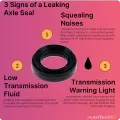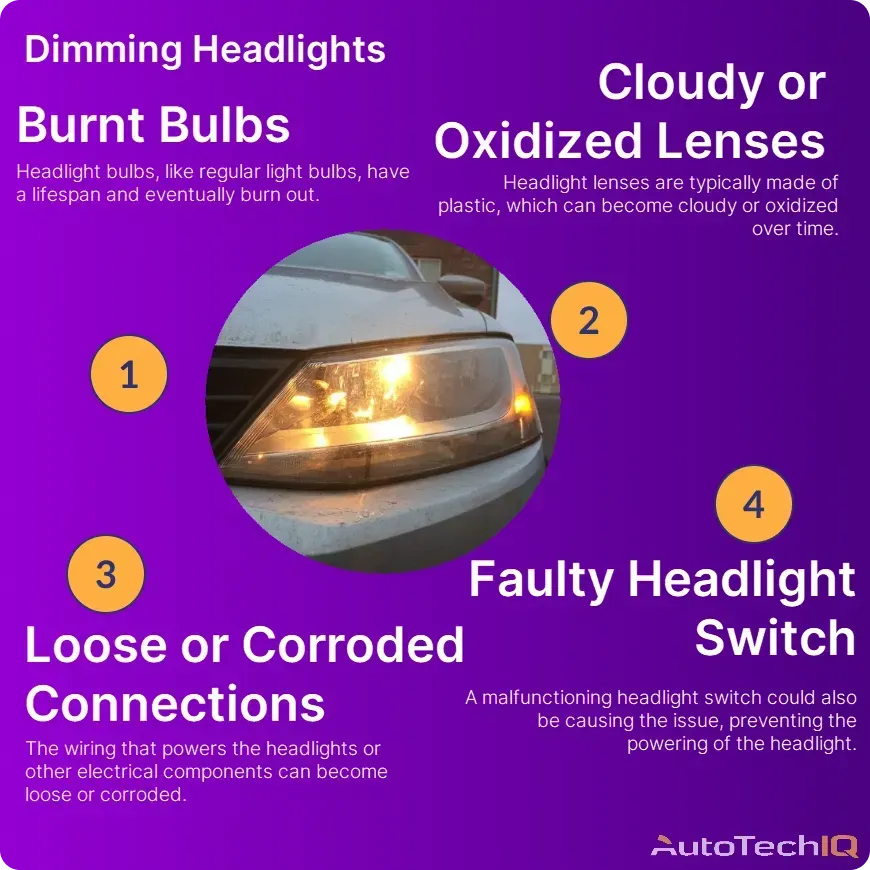
Dim headlights can be caused by a few different things, ranging from simple fixes to more complex issues. Here are the most common culprits:
Burnt-out bulbs: This is the most common reason for dim headlights. The headlight bulb, like regular halogen bulbs, has a lifespan and eventually burns out. If one or both headlights seem significantly dimmer than usual, replacing the bulb(s) is likely the solution.
Cloudy or oxidized lenses: Headlight lenses are typically made of plastic, which can become cloudy or oxidized over time due to exposure to sunlight and the elements. This clouding reduces the amount of light that can pass through, making the headlights appear dimmer, even if you use LED bulbs. Typically this isolates a faulty headlight, so you'll notice brighter headlights on the rear and front, with only one being faulty.
Loose or corroded electrical connections: Headlights are similar to traditional incandescent bulbs in having wires and requiring proper power. So, issues in the wires and connections will affect the light output. The wiring harness that powers the headlights or other electrical components can become loose or corroded over time, leading to decreased power and dimmer lights. The "battery warning" light might also appear depending on the damage's location.

Dimming caused by other electrical issues: In some cases, dim headlights can be a symptom of a more serious electrical problem, such as a failing alternator or battery. These issues can also affect other electrical components in your car like power windows.
Headlight switch malfunction: While less common, a malfunctioning headlight switch could also be causing the issue. So, regardless if you use LED or halogen lights, a faulty switch won't allow it to work.
Other possibilities: Depending on your car model, there could be other factors at play, such as worn headlight reflectors, incorrect headlight aiming, rusty headlight assembly, or specific issues with the headlight system itself.
Why are my headlines still dim after replacing the bulb?
Even if the headlights feature working incandescent bulbs, or LED headlight bulbs, other components from the battery system may be related to the problem. Here's how they can contribute to the issue:
Alternator:
- Main function: The alternator charges the battery while the engine is running and supplies power to the electrical system. It can develop various issues that affect the alternator belt or other internal components.
- Signs of a bad alternator:
- Dimming headlights, especially noticeable at idle or with other electrical loads on.
- Flickering lights or other electrical components.
- Warning lights on your dashboard, like the battery light.
- Difficulty starting the car.
- Whining or humming noise from the alternator.

Battery:
- Main function: Car batteries store energy to power the car's electrical systems when the engine is off and supplement the alternator during high electrical demand.
- Signs of a weak battery:
- Dimming headlights, even without other electrical loads.
- Slow engine cranking when starting the car.
- Electrical malfunctions like flickering lights or radio issues.
- Warning lights on your dashboard, like the battery light.
- The car doesn't start in cold weather.

Diagnosing the culprit:
It can be tricky to pinpoint the exact culprit by just the dimmed headlights symptom. Here are some tips to help you:
- Observe the dimming: Does it happen only at idle, or even while driving? Does it worsen with other electrical loads like the radio or AC?
- Check the battery: Look for signs of corrosion, swelling, or leakage. You can also get it tested at most auto parts stores or service centers.
- Monitor other electrical components: Do other electrical systems seem sluggish or malfunctioning?
- Consider warning lights: Any illuminated warning lights on your dashboard can offer valuable clues.
What to do:
If you're experiencing dim headlights, here are some steps you can take:
- Visually inspect the headlights: Check for any signs of damage or burnt-out bulbs. You can also look for clouding or yellowing of the lenses.
- Consult your car's owner's manual: Your manual will often have specific instructions on how to replace headlight bulbs and troubleshoot other headlight problems.
- Consider visiting a mechanic: If you're not comfortable troubleshooting the issue yourself, or if you suspect a more complex problem, take your car to a qualified mechanic for diagnosis and repair. Fog lights are important for safety and are also affected by this issue, so consider being prompt to repair them. Call a Shop nearby (you can find one here).
Other news
-
Car is Squealing When Driving
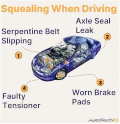
-
What is Preventative Maintenance and What Are The Benefits of it?

-
JobViewIQ - DVI Process Training - Part of the Auto Care Alliance Benefits

-
7 Signs of AC Pulley Issues
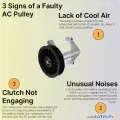
-
7 Signs of Clogged AC Components
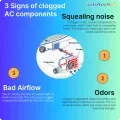
-
How Much Does a Transmission Fluid Change Cost?

-
7 Signs of a Leaking Axle Seal
